Remote Sensing-Based Quantification of the Relationships between Land Use Land Cover Changes and Surface Temperature over the Lower Himalayan Region
Abstract
:1. Introduction
2. Materials and Methods
2.1. Study Area
2.2. Data
2.3. Methods
2.3.1. Classification Schema for LULC and Assessment of Its Accuracy
2.3.2. Estimation of LST
2.3.3. Normalization of LST
2.3.4. Modeling of LULC Changes for 2032 and 2047
2.3.5. Modeling of LST for 2032 and 2047
3. Results
3.1. Past Pattern of LULC Classes
3.2. Past Pattern of LST
3.3. Modeling of LULC Changes for the Year 2032 and 2047
3.4. Modeling of LST Changes for the Years 2032 and 2047
4. Discussions
4.1. Change in LULC
4.2. Change in LST
4.3. Modeling of LULC Changes for the Year 2032 and 2047
4.4. Modeling of LST Changes for the Year 2032 and 2047
5. Conclusions
Author Contributions
Funding
Acknowledgments
Conflicts of Interest
References
- Aguilar, A.G.; Ward, P. Globalization, regional development, and mega-city expansion in Latin America: Analyzing Mexico City’s peri-urban hinterland. Cities 2003, 20, 3–21. [Google Scholar] [CrossRef]
- Yuen, B.; Kong, L. Climate change and urban planning in Southeast Asia. SAPI EN. S. Surv. Perspect. Integr. Environ. Soc. 2009, 2, 3. [Google Scholar]
- Verburg, P.H.; Van De Steeg, J.; Veldkamp, A.; Willemen, L. From land cover change to land function dynamics: A major challenge to improve land characterization. J. Environ. Manag. 2009, 90, 1327–1335. [Google Scholar] [CrossRef] [PubMed]
- Uttara, S.; Elliot, S. Impacts of urbanization on environment. Int. J. Res. Eng. Appl. Sci. 2012, 2, 1637–1645. [Google Scholar]
- Maimaitiyiming, M.; Ghulam, A.; Tiyip, T.; Pla, F.; Latorre-Carmona, P.; Halik, Ü.; Sawut, M.; Caetano, M. Effects of green space spatial pattern on land surface temperature: Implications for sustainable urban planning and climate change adaptation. ISPRS J. Photogramm. Remote Sens. 2014, 89, 59–66. [Google Scholar] [CrossRef] [Green Version]
- Gaffin, S.R.; Rosenzweig, C.; Khanbilvardi, R.; Parshall, L.; Mahani, S.; Glickman, H.; Goldberg, R.; Blake, R.; Slosberg, R.B.; Hillel, D. Variations in New York city’s urban heat island strength over time and space. Theor. Appl. Climatol. 2008, 94, 1–11. [Google Scholar] [CrossRef]
- Zhang, Y.; Balzter, H.; Liu, B.; Chen, Y. Analyzing the impacts of urbanization and seasonal variation on land surface temperature based on subpixel fractional covers using Landsat images. IEEE. J. Sel. Top. Appl. Earth Obs. Remote Sens. 2017, 10, 1344–1356. [Google Scholar] [CrossRef]
- Xiao, R.B.; Weng, Q.H.; Ouyang, Z.Y.; Li, W.F.; Schienke, E.W.; Zhang, Z.M. Land surface temperature variation and major factors in Beijing, China. Photogramm. Eng. Remote Sens. 2008, 74, 451–461. [Google Scholar] [CrossRef]
- Li, X.; Zhou, W.; Ouyang, Z.; Xu, W.; Zheng, H. Spatial pattern of greenspace affects land surface temperature: Evidence from the heavily urbanized Beijing metropolitan area, China. Landsc. Ecol. 2012, 27, 887–898. [Google Scholar] [CrossRef]
- Boos, W.R.; Kuang, Z. Dominant control of the south Asian monsoon by orographic insulation versus plateau heating. Nature 2010, 463, 218. [Google Scholar] [CrossRef] [PubMed]
- Cao, W.; Huang, L.; Liu, L.; Zhai, J.; Wu, D. Overestimating impacts of urbanization on regional temperatures in developing megacity: Beijing as an example. Adv. Meteorol. 2019, 2019, 3985715. [Google Scholar] [CrossRef]
- Lai, L.W.; Cheng, W.L. Urban heat island and air pollution—An emerging role for hospital respiratory admissions in an urban area. J. Environ. Health 2010, 72, 32–35. [Google Scholar] [PubMed]
- United Nations, Department of Economic and Social Affairs. P.D. World Urbanization Prospects: The 2018 Revision; United Nations, Department of Economic and Social Affairs: New York, NY, USA, 2018. [Google Scholar]
- Yang, C.; He, X.; Yan, F.; Yu, L.; Bu, K.; Yang, J.; Chang, L.; Zhang, S. Mapping the influence of land use/land cover changes on the urban heat island effect—A case study of Changchun, China. Sustainability 2017, 9, 312. [Google Scholar] [CrossRef]
- Ahmed, S. Assessment of urban heat islands and impact of climate change on socioeconomic over Suez governorate using remote sensing and GIS techniques. Egypt. J. Remote Sens. Space Sci. 2018, 21, 15–25. [Google Scholar] [CrossRef]
- Balzter, H. Markov chain models for vegetation dynamics. Ecol. Model. 2000, 126, 139–154. [Google Scholar] [CrossRef] [Green Version]
- Santé, I.; García, A.M.; Miranda, D.; Crecente, R. Cellular automata models for the simulation of real-world urban processes: A review and analysis. Landsc. Urban Plan. 2010, 96, 108–122. [Google Scholar] [CrossRef]
- Zenil, H. Compression-based investigation of the dynamical properties of cellular automata and other systems. arXiv 2009, arXiv:0910.4042. [Google Scholar]
- Civco, D.L. Artificial neural networks for land-cover classification and mapping. Int. J. Geogr. Inf. Sci. 1993, 7, 173–186. [Google Scholar] [CrossRef]
- Agarwal, C.; Green, G.M.; Grove, J.M.; Evans, T.P.; Schweik, C.M. A Review and Assessment of Land-Use Change Models: Dynamics of Space, Time, and Human Choice; Gen. Tech. Rep. NE-297; Newton Square, U.S. Department of Agriculture, Forest Service, Northeastern Research Station: Washington, DC, USA, 2002; 61p. [Google Scholar]
- Weng, Q. Land use change analysis in the Zhujiang Delta of China using satellite remote sensing, GIS and stochastic modelling. J. Environ. Manag. 2002, 64, 273–284. [Google Scholar] [CrossRef] [Green Version]
- Kumar, S.; Radhakrishnan, N.; Mathew, S. Land use change modelling using a markov model and remote sensing. Geomat. Nat. Hazards Risk 2014, 5, 145–156. [Google Scholar] [CrossRef]
- Parsa, V.A.; Salehi, E. Spatio-temporal analysis and simulation pattern of land use/cover changes, case study: Naghadeh, Iran. J. Urban Manag. 2016, 5, 43–51. [Google Scholar] [CrossRef] [Green Version]
- Hadi, S.J.; Shafri, H.Z.M.; Mahir, M.D. Modelling LULC for the period 2010–2030 using GIS and remote sensing: A case study of Tikrit, Iraq. In IOP Conference Series: Earth and Environmental Science; IOP Publishing: Bristol, UK, 2014; Volume 20, p. 12053. [Google Scholar]
- Rahaman, K.R.; Ahmed, M.R.; Hassan, Q.K. Using satellite-borne remote sensing data in generating local warming maps with enhanced resolution. ISPRS Int. J. Geo-Inf. 2018, 7, 398. [Google Scholar] [CrossRef]
- Eastman, J.R. Idrisi Taiga; Clark Labs Clark University: Worcester, MA, USA, 2009. [Google Scholar]
- Ullah, S.; Ahmad, K.; Sajjad, R.U.; Abbasi, A.M.; Nazeer, A.; Tahir, A.A. Analysis and simulation of land cover changes and their impacts on land surface temperature in a lower Himalayan region. J. Environ. Manag. 2019, 245, 348–357. [Google Scholar] [CrossRef] [PubMed]
- Guan, D.; Li, H.; Inohae, T.; Su, W.; Nagaie, T.; Hokao, K. Modeling urban land use change by the integration of cellular automaton and markov model. Ecol. Model. 2011, 222, 3761–3772. [Google Scholar] [CrossRef]
- Keshtkar, H.; Voigt, W. A spatiotemporal analysis of landscape change using an integrated markov chain and cellular automata models. Model. Earth Syst. Environ. 2016, 2, 10. [Google Scholar] [CrossRef]
- Hu, Y.; Jia, G. Influence of land use change on urban heat island derived from multi-sensor data. Int. J. Climatol. 2010, 30, 1382–1395. [Google Scholar] [CrossRef]
- Li, J.; Wang, X.; Wang, X.; Ma, W.; Zhang, H. Remote sensing evaluation of urban heat island and its spatial pattern of the Shanghai Metropolitan Area, China. Ecol. Complex. 2009, 6, 413–420. [Google Scholar] [CrossRef]
- Xu, L.Y.; Xie, X.D.; Li, S. Correlation analysis of the urban heat island effect and the spatial and temporal distribution of atmospheric particulates using TM images in Beijing. Environ. Pollut. 2013, 178, 102–114. [Google Scholar] [CrossRef]
- Jiang, J.; Tian, G. Analysis of the impact of land use/land cover change on land surface temperature with remote sensing. Procedia Environ. Sci. 2010, 2, 571–575. [Google Scholar] [CrossRef]
- Mushore, T.D.; Mutanga, O.; Odindi, J.; Dube, T. Assessing the potential of integrated Landsat 8 thermal bands, with the traditional reflective bands and derived vegetation indices in classifying urban landscapes. Geocarto Int. 2017, 32, 886–899. [Google Scholar] [CrossRef]
- Sung, C.Y. Mitigating surface urban heat island by a tree protection policy: A case study of the Woodland, Texas, USA. Urban Green. 2013, 12, 474–480. [Google Scholar] [CrossRef]
- Odindi, J.O.; Bangamwabo, V.; Mutanga, O. Assessing the value of urban green spaces in mitigating multi-seasonal urban heat using MODIS land surface temperature (LST) and Landsat 8 data. Int. J. Environ. Res. 2015, 9, 9–18. [Google Scholar]
- Xiao, H.; Kopecká, M.; Guo, S.; Guan, Y.; Cai, D.; Zhang, C.; Zhang, X.; Yao, W. Responses of urban land surface temperature on land cover: A comparative study of Vienna and Madrid. Sustainability 2018, 10, 260. [Google Scholar] [CrossRef]
- Yuan, F.; Bauer, M.E. Comparison of impervious surface area and normalized difference vegetation index as indicators of surface urban heat island effects in Landsat imagery. Remote Sens. Environ. 2007, 106, 375–386. [Google Scholar] [CrossRef]
- Tran, H.; Uchihama, D.; Ochi, S.; Yasuoka, Y. Assessment with satellite data of the urban heat island effects in Asian Mega Cities. Int. J. Appl. Earth Obs. Geoinf. 2006, 8, 34–48. [Google Scholar] [CrossRef]
- Ahmed, B.; Kamruzzaman, M.; Zhu, X.; Rahman, M.S.; Choi, K. Simulating land cover changes and their impacts on land surface temperature in Dhaka, Bangladesh. Remote Sens. 2013, 5, 5969–5998. [Google Scholar] [CrossRef]
- Weng, Q.; Lu, D.; Schubring, J. Estimation of land surface temperature-vegetation abundance relationship for urban heat island studies. Remote Sens. Environ. 2004, 89, 467–483. [Google Scholar] [CrossRef]
- Hasanlou, M.; Mostofi, N. Investigating urban heat island estimation and relation between various land cover indices in Tehran city using Landsat 8 imagery. In Proceedings of the 1st International Electronic Conference on Remote Sensing, Basel, Switzerland, 22 June–5 July 2015; pp. 1–11. [Google Scholar]
- Mushore, T.D.; Odindi, J.; Dube, T.; Mutanga, O. Prediction of future urban surface temperatures using medium resolution satellite data in Harare Metropolitan City, Zimbabwe. Build. Environ. 2017, 122, 397–410. [Google Scholar] [CrossRef]
- Pakistan Bureau of Statistics. District Wise Census Results [WWW Document]. Available online: http://www.pbscensus.gov.pk/sites/default/files/bwpsr/kp/ABBOTTABAD_SUMMARY.pdf (accessed on 20 January 2019).
- Kottek, M.; Grieser, J.; Beck, C.; Rudolf, B.; Rubel, F. World map of the Köppen-Geiger climate classification updated. Meteorol. Z. 2006, 15, 259–263. [Google Scholar] [CrossRef]
- Afzaal, M.; Haroon, M.A.; Zaman, Q. Interdecadal oscillations and the warming trend in the area-weighted annual mean temperature of Pakistan. Pak. J. Meteorol. 2009, 6, 13–19. [Google Scholar]
- Landsat, N. Science Data Users Handbook; NASA: Washington, DC, USA, 2019. [Google Scholar]
- Anderson, J.R. A Land Use and Land Cover Classification System for Use with Remote Sensor Data; US Government Printing Office: Washington, DC, USA, 1976; Volume 964.
- Rozenstein, O.; Karnieli, A. Comparison of methods for land-use classification incorporating remote sensing and GIS inputs. Appl. Geogr. 2011, 31, 533–544. [Google Scholar] [CrossRef]
- Vapnik, V.N.; Chervonenkis, A.Y. The uniform convergence of frequencies of the appearance of events to their probabilities. In Doklady Akademii Nauk; Russian Academy of Sciences: Moscow, Russia, 1968; Volume 181, pp. 781–783. [Google Scholar]
- Vapnik, V.N. An overview of statistical learning theory. IEEE Trans. Neural Netw. 1999, 10, 988–999. [Google Scholar] [CrossRef] [PubMed]
- Foody, G.M. Status of land cover classification accuracy assessment. Remote Sens. Environ. 2002, 80, 185–201. [Google Scholar] [CrossRef]
- Artis, D.A.; Carnahan, W.H. Survey of emissivity variability in thermography of urban areas. Remote Sens. Environ. 1982, 12, 313–329. [Google Scholar] [CrossRef]
- Sobrino, J.A.; Jiménez-Muñoz, J.C.; Paolini, L. Land surface temperature retrieval from Landsat TM 5. Int. J. Appl. Sci. Technol. 2004, 90, 434–440. [Google Scholar] [CrossRef]
- Salama, M.S.; Van der Velde, R.; Zhong, L.; Ma, Y.; Ofwono, M.; Su, Z. Decadal variations of land surface temperature anomalies observed over the Tibetan plateau by the special sensor microwave imager (SSM/I) from 1987 to 2008. Clim. Chang. 2012, 114, 769–781. [Google Scholar] [CrossRef]
- Triantakonstantis, D.; Mountrakis, G. Urban growth prediction: A review of computational models and human perceptions. J. Geogr. Inf. Syst. 2012, 4, 555–587. [Google Scholar] [CrossRef]
- Sarkar, L.; Rasheduzzaman, M.; Zahedul Islam, A.Z.M.; Tabassum, F.; Saba, H.; Uddin, S.Z.; Rahman, M.T.U.; Ferdous, J. Temporal dynamics of land use/land cover change and its prediction using CA-ANN model for southwestern coastal Bangladesh. Environ. Monit. Assess. 2017, 189, 565. [Google Scholar] [CrossRef]
- Chen, X.-L.; Zhao, H.-M.; Li, P.-X.; Yin, Z.-Y. Remote sensing image-based analysis of the relationship between urban heat island and land use/cover changes. Remote Sens. Environ. 2006, 104, 133–146. [Google Scholar] [CrossRef]
- Zha, Y.; Gao, J.; Ni, S. Use of normalized difference built-up index in automatically mapping urban areas from TM imagery. Int. J. Remote Sens. 2003, 24, 583–594. [Google Scholar] [CrossRef]
- Katayama, R.; Shozi, M.; Tokiya, Y. A research on the urban disaster prevention plan concerning earthquake risk forecast by remoto sensing in the Tokyo Bay Area. ISPRS 2000, B7, 669. [Google Scholar]
- Thapa, R.B.; Murayama, Y. Examining spatiotemporal urbanization patterns in Kathmandu Valley, Nepal: Remote sensing and spatial metrics approaches. Remote Sens. 2009, 1, 534–556. [Google Scholar] [CrossRef]
- Dewan, A.; Corner, R. Dhaka Megacity: Geospatial Perspectives on Urbanisation, Environment and Health; Springer Science and Business Media: Berlin, Germany, 2013. [Google Scholar]
- Pakistan Bureau of Statistics. Tehsil Wise Census Results [WWW Document]. Available online: http://www.pbscensus.gov.pk/sites/default/files/bwpsr/kp/ABBOTTABAD_SUMMARY.pdf (accessed on 20 January 2019).
- Weng, Q. A remote sensing? GIS evaluation of urban expansion and its impact on surface temperature in the Zhujiang Delta, China. Int. J. Remote Sens. 2001, 22, 1999–2014. [Google Scholar]
- Abou-Korin, A.A. Impacts of rapid urbanisation in the Arab World: The case of Dammam metropolitan area, Saudi Arabia. In Proceedings of the 5th International Conference and Workshop on Built Environment in Developing Countries (ICBEDC 2011), Penang, Malaysia, 6–7 December 2011; pp. 1–25. [Google Scholar]
- Adegoke, J.O.; Pielke, S.R.A.; Eastman, J.; Mahmood, R.; Hubbard, K.G. Impact of irrigation on midsummer surface fluxes and temperature under dry synoptic conditions: A regional atmospheric model study of the US high plains. Mon. Weather Rev. 2003, 131, 556–564. [Google Scholar] [CrossRef]
- Terando, A.J.; Costanza, J.; Belyea, C.; Dunn, R.R.; McKerrow, A.; Collazo, J.A. The southern megalopolis: Using the past to predict the future of urban sprawl in the Southeast US. PLoS ONE 2014, 9, e102261. [Google Scholar] [CrossRef]
- Ren, G.; Zhou, Y.; Chu, Z.; Zhou, J.; Zhang, A.; Guo, J.; Liu, X. Urbanization effects on observed surface air temperature trends in North China. J. Clim. 2008, 21, 1333–1348. [Google Scholar] [CrossRef]
- Han, H.; Yang, C.; Song, J. Scenario simulation and the prediction of land use and land cover change in Beijing, China. Sustainability 2015, 7, 4260–4279. [Google Scholar] [CrossRef]
- Hasan, S.; Deng, X.; Li, Z.; Chen, D. Projections of future land use in Bangladesh under the background of baseline, ecological protection and economic development. Sustainability 2017, 9, 505. [Google Scholar] [CrossRef]
- DESA, U.N. United Nations Department of Economic and Social Affairs/Population Division (2009b): World Population Prospects: The 2008 Revision. Available online: http//esa.un.org/unpp (accessed on 25 May 2019).
- Bhatta, B. Causes and consequences of urban growth and sprawl. In Analysis of Urban Growth and Sprawl from Remote Sensing Data; Advances in Geographic Information Science; Springer: Berlin/Heidelberg, Germany, 2010; pp. 17–36. [Google Scholar]
- Isaac, M.; Van Vuuren, D.P. Modeling global residential sector energy demand for heating and air conditioning in the context of climate change. Energy Policy 2009, 37, 507–521. [Google Scholar] [CrossRef]
- Satterthwaite, D. Climate change and urbanization: Effects and implications for urban governance. In United Nations Expert Group Meeting on Population Distribution, Urbanization, Internal Migration and Development; DESA: New York, NY, USA, 2008; pp. 21–23. [Google Scholar]
- Pilli-Sihvola, K.; Aatola, P.; Ollikainen, M.; Tuomenvirta, H. Climate change and electricity consumption—Witnessing increasing or decreasing use and costs? Energy Policy 2010, 38, 2409–2419. [Google Scholar] [CrossRef]
- Kahn, M.E. Urban growth and climate change. Annu. Rev. Resour. Econ. 2009, 1, 333–350. [Google Scholar] [CrossRef]
- Svirejeva-Hopkins, A.; Schellnhuber, H.J.; Pomaz, V.L. Urbanized territories as a specific component of the global carbon cycle. Ecol. Model. 2004, 173, 295–312. [Google Scholar] [CrossRef]
- Chaudhry, Q.U.Z. Climate Change Profile of Pakistan; Asian Development Bank: Metro Manila, Philippines, 2017. [Google Scholar] [CrossRef]
- Li, Z.; Guo, X.; Dixon, P.; He, Y. Applicability of land surface temperature (LST) estimates from AVHRR satellite image composites in northern Canada. Prairie Perspect. 2008, 11, 119–130. [Google Scholar]
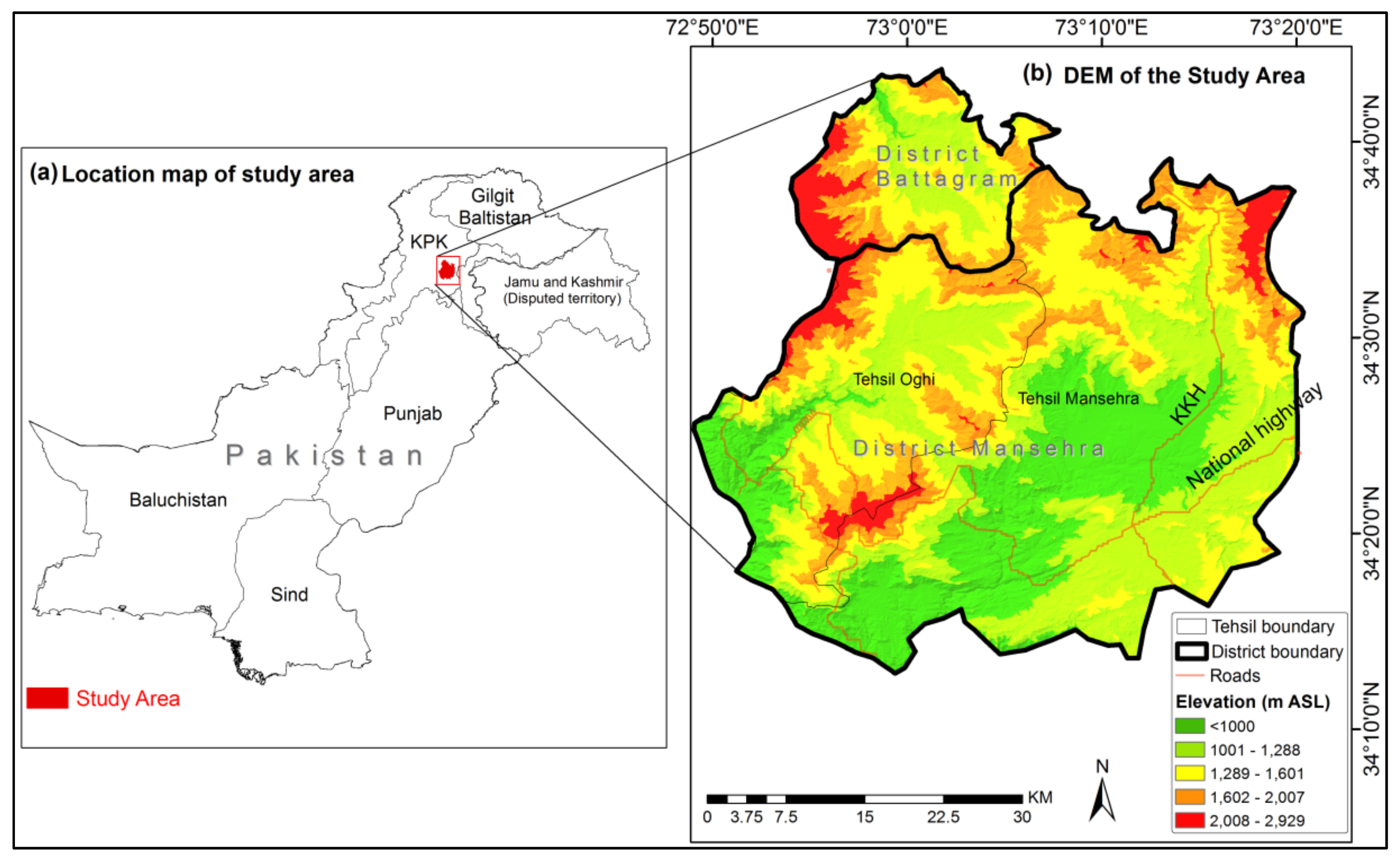
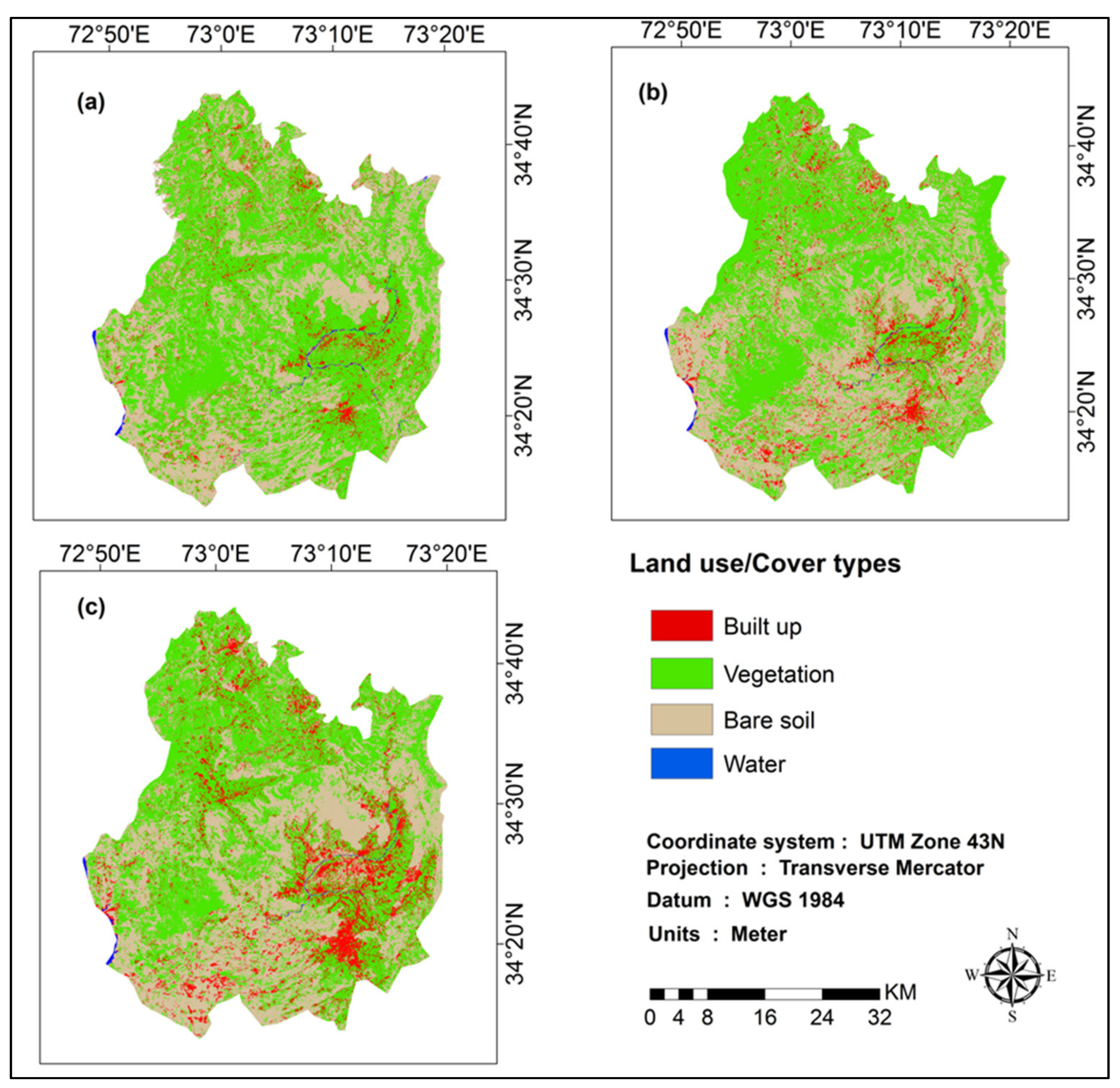
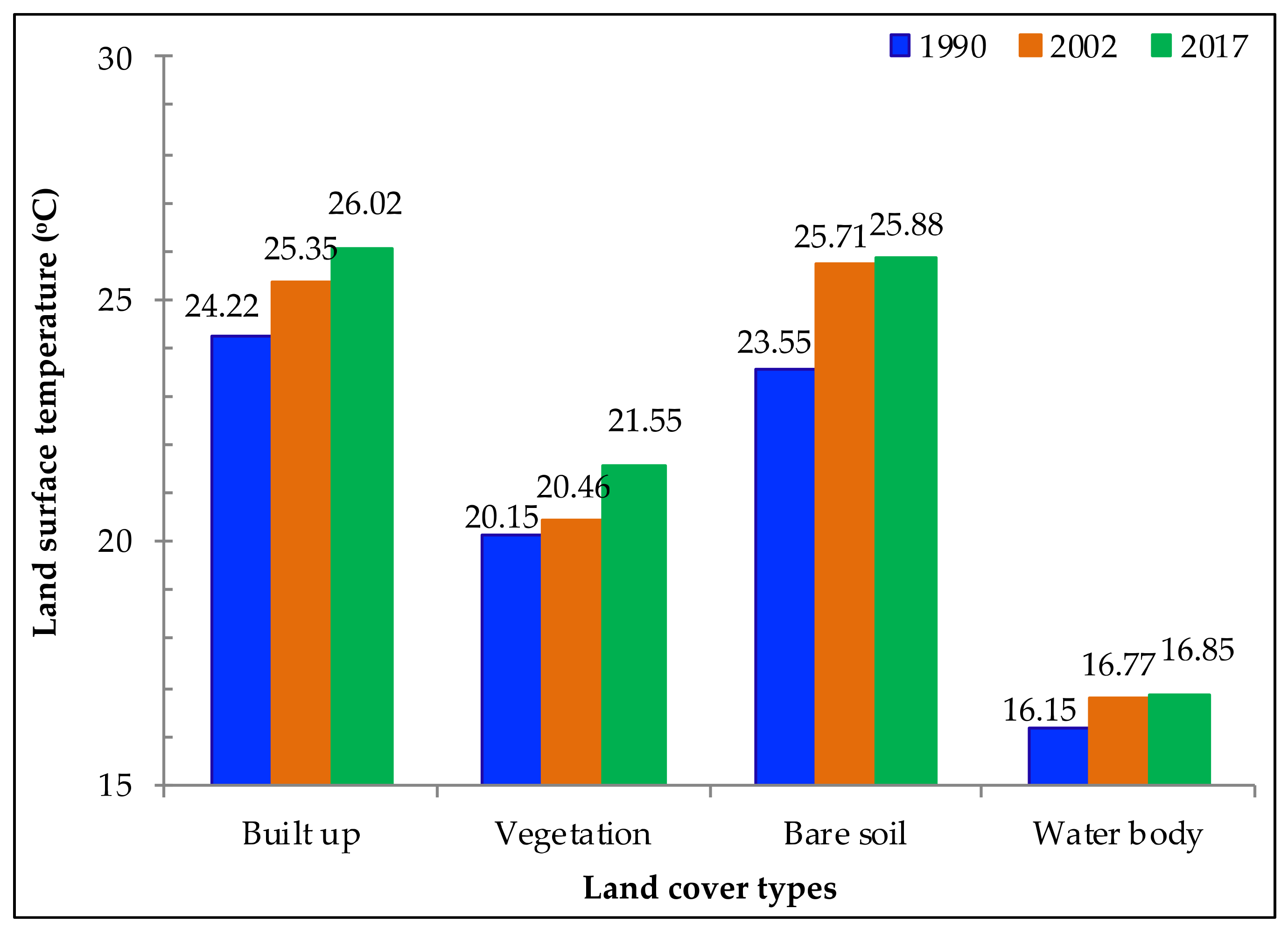
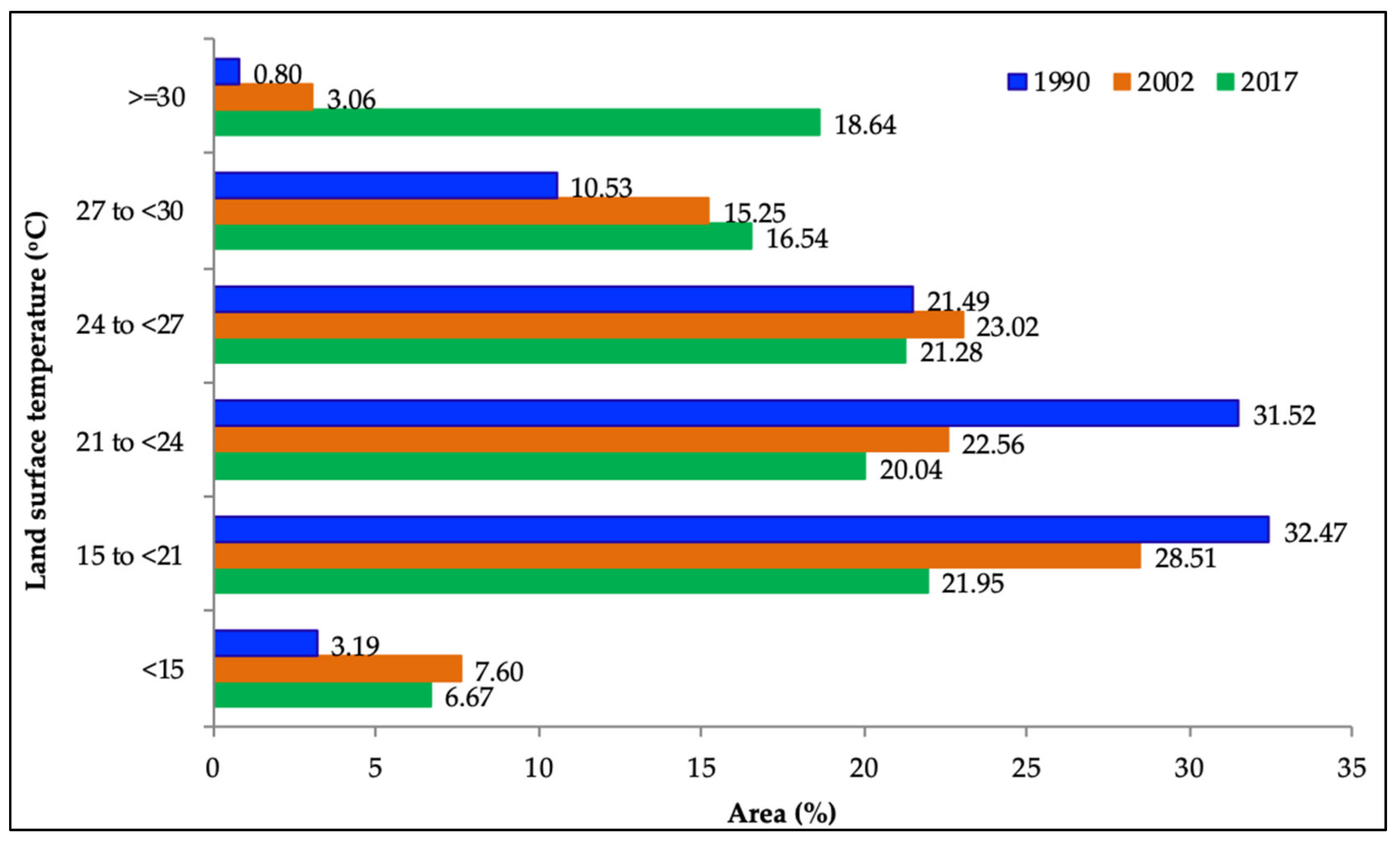
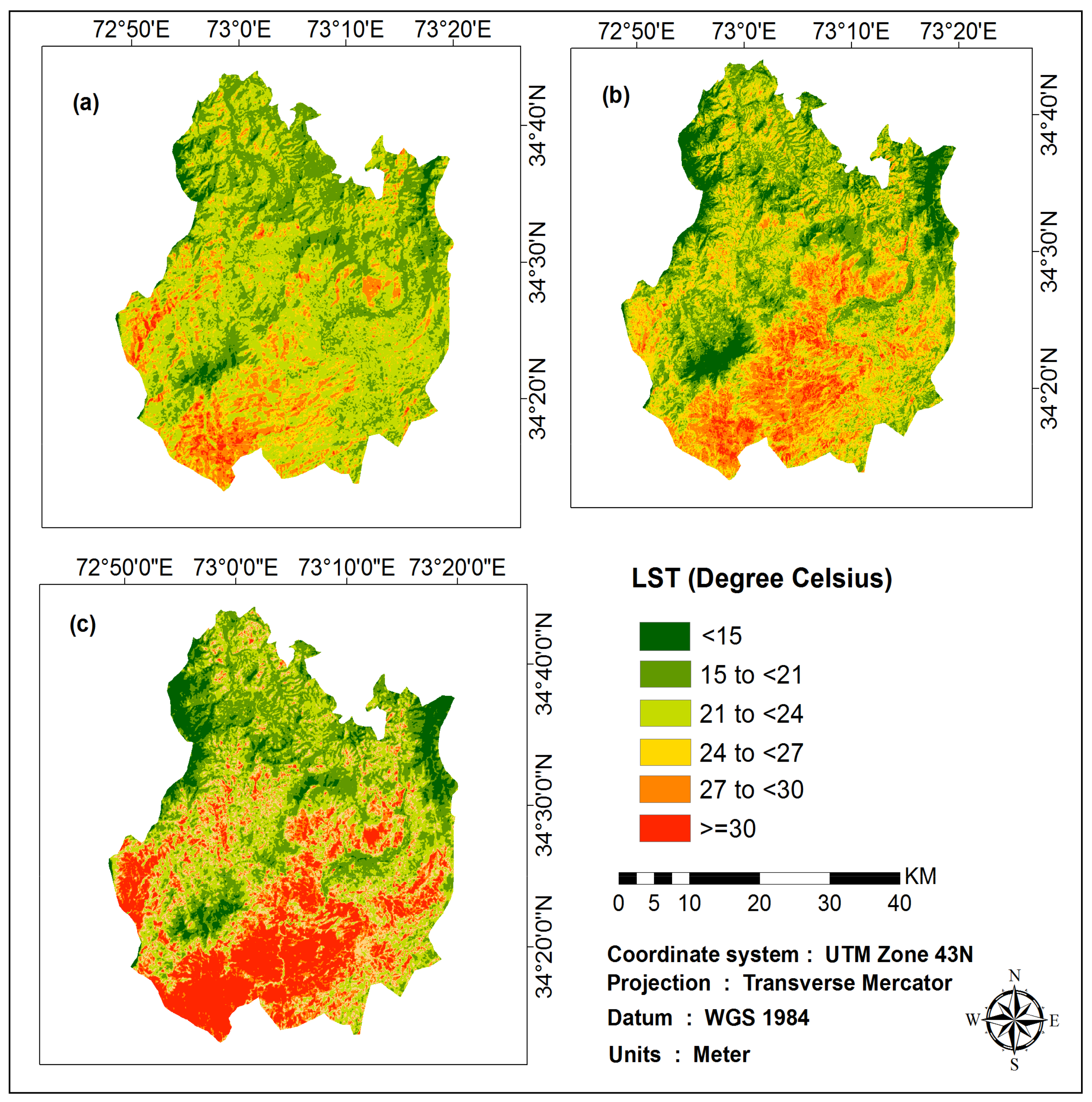


| Date | Sensor | Cloud Cover (%) |
|---|---|---|
| 24 April 1990 | Landsat 5 TM | ~1% |
| 19 May 2002 | Landsat 7 ETM+ | ~8% |
| 20 May 2017 | Landsat 8 OLI | ~13% |
| Index | Equation | |
|---|---|---|
| Landsat 5 and 7 | Landsat 8 | |
| NDBaI | ||
| NDVI | ||
| NDBI | ||
| UI | ||
| Year | User Accuracy (%) | Producer Accuracy (%) | Overall Accuracy (%) | Kappa Coefficient |
|---|---|---|---|---|
| 1990 | 96.34 | 93.15 | 94.96 | 0.92 |
| 2002 | 96.34 | 86.24 | 92.26 | 0.88 |
| 2017 | 93.67 | 92.84 | 91.35 | 0.87 |
| Class Name | 1990 | 2002 | 2017 | Change (km2) | Net Change (%) | |
|---|---|---|---|---|---|---|
| (1990‒2002) | (2002‒2017) | (1990‒2017) | ||||
| Built-up Area | 93.11 | 134.85 | 196.98 | +41.74 | +62.13 | +5.75 |
| Vegetation | 1017.66 | 933.25 | 841.89 | −85.14 | −90.36 | −9.88 |
| Bare Soil | 681.61 | 730.23 | 759.41 | +48.62 | +29.18 | +4.22 |
| Water Body | 5.86 | 4.24 | 4.18 | −1.62 | −0.06 | −0.001 |
| Land Class | Area (%) During Projected Years | |
|---|---|---|
| 2032 | 2047 | |
| Built-up | 12.48 | 14.65 |
| Vegetation | 45.03 | 42.61 |
| Bare soil | 42.35 | 42.63 |
| Water body | 0.12 | 0.08 |
| LST Ranges | Areal Coverage (%) During Projected Years | |
|---|---|---|
| 2032 | 2047 | |
| <15 | 0 | 0 |
| 15 to <21 | 0 | 0 |
| 21 to <24 | 0 | 0 |
| 24 to <27 | 5.18 | 0 |
| 27 to <30 | 50.79 | 41.97 |
| =>30 | 44.01 | 58.02 |
© 2019 by the authors. Licensee MDPI, Basel, Switzerland. This article is an open access article distributed under the terms and conditions of the Creative Commons Attribution (CC BY) license (http://creativecommons.org/licenses/by/4.0/).
Share and Cite
Ullah, S.; Tahir, A.A.; Akbar, T.A.; Hassan, Q.K.; Dewan, A.; Khan, A.J.; Khan, M. Remote Sensing-Based Quantification of the Relationships between Land Use Land Cover Changes and Surface Temperature over the Lower Himalayan Region. Sustainability 2019, 11, 5492. https://doi.org/10.3390/su11195492
Ullah S, Tahir AA, Akbar TA, Hassan QK, Dewan A, Khan AJ, Khan M. Remote Sensing-Based Quantification of the Relationships between Land Use Land Cover Changes and Surface Temperature over the Lower Himalayan Region. Sustainability. 2019; 11(19):5492. https://doi.org/10.3390/su11195492
Chicago/Turabian StyleUllah, Siddique, Adnan Ahmad Tahir, Tahir Ali Akbar, Quazi K. Hassan, Ashraf Dewan, Asim Jahangir Khan, and Mudassir Khan. 2019. "Remote Sensing-Based Quantification of the Relationships between Land Use Land Cover Changes and Surface Temperature over the Lower Himalayan Region" Sustainability 11, no. 19: 5492. https://doi.org/10.3390/su11195492
APA StyleUllah, S., Tahir, A. A., Akbar, T. A., Hassan, Q. K., Dewan, A., Khan, A. J., & Khan, M. (2019). Remote Sensing-Based Quantification of the Relationships between Land Use Land Cover Changes and Surface Temperature over the Lower Himalayan Region. Sustainability, 11(19), 5492. https://doi.org/10.3390/su11195492








